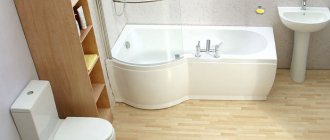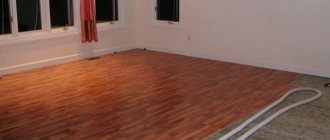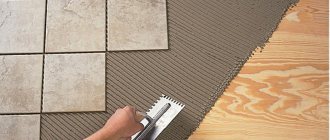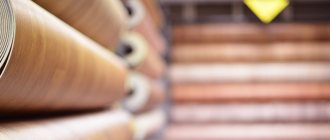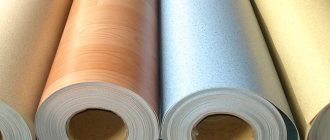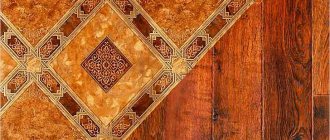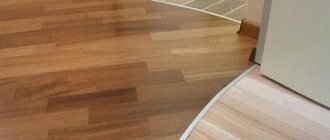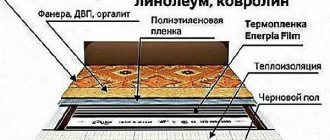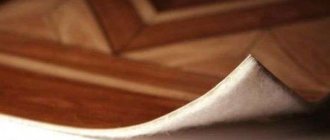To lay linoleum, you need to achieve a flat base surface. So the idea of laying linoleum on top of linoleum (without removing the old sheets) seems attractive. Professionals in the field of finishing work say that this is an acceptable technology, but it cannot be used in all cases. Let's figure out when it is possible to lay new linoleum on top of the old one, and when it is better to remove the old layer.
Requirements for the quality of the base for linoleum
Linoleum is the most popular type of flooring in our country. It successfully combines affordable cost, varied design, low maintenance requirements and ease of flooring. But, despite its unpretentiousness, this material makes certain demands on the base on which it will be laid:
- The surface must be smooth. According to the standards, a height difference of no more than 2 mm is allowed on any two-meter vector. This is due to the relative plasticity of linoleum: all the features of the relief will appear on the coating over time. And if there are dents or protrusions in the base, these will become points where the material will break through in the future.
- It is unacceptable for moisture to get under the linoleum. Water will cause the material to ripple and the floor will be hopelessly damaged. Therefore, the base must be thoroughly dried.
- The floor on which linoleum will be laid must have sufficient hardness. A base that is too soft will wash out along with the canvas (under the weight of furniture, pressure from heels, falling objects, etc.), which will ruin the look and lead to the appearance of holes.
Using laminate tiles instead of sheet linoleum does not soften the requirements, but, on the contrary, makes them more stringent. On an uneven base, the locks will constantly come apart, and the coating will quickly lose its aesthetic appearance.
A floor covered with linoleum theoretically satisfies all requirements. It must be carefully leveled and isolated from water even at the time of laying the old canvas. Therefore, the idea of installing a new layer on top of the old one that has not been removed looks very attractive.
Choosing a good flooring material
You already know whether it is possible to lay linoleum on linoleum in your case. The article on how to choose linoleum describes which types are suitable for an apartment. In fact, a lot depends on the room and its traffic.
- It is advisable to choose high-quality material for your home. This will be at least semi-commercial linoleum on a warm base. Make sure that the protective layer is at least 0.35 mm.
- In public buildings, as a rule, homogeneous commercial material is laid. It is quite hard and dense.
- Thin household linoleum must be glued to the old one with 2-sided tape or glue. After all, it can jump out from under the baseboard and go like a wave.
Many sites advise leaving the rolls in the room for several days after purchasing. Supposedly to get used to the room and its temperature. In fact, modern PVC material can be laid immediately after purchase. If it sits in rolls for 2-3 days, it’s just wasted time. This is not a laminate, it does not expand or contract.
Then they write that after rolling you need to wait another 1-2 days. It seems to be used to level the coating. This is all nonsense.
Laying features:
- Remove the baseboards. Unfortunately, they are unlikely to return to their old place;
- Remove all debris from the floor and sweep it up. God forbid you forget the screws for the baseboards under the linoleum;
- Roll out the roll in the room and smooth it out. One edge should fit snugly against the wall to avoid unnecessary cutting.
- Cut off excess in corners, near the wall and near the radiator;
- Unscrew the material to secure it with double-sided tape or glue (if necessary);
- We put the baseboard in place, it is important to press it securely to the floor. A drill may be needed here.
Don't forget about the thresholds between rooms. If you plan to replace linoleum in only one room, there will be a difference in the floors.
Five reasons not to remove old coating
The attractiveness of each renovation solution can be assessed by reviewing the benefits it can provide.
This is what laying a new layer of linoleum on top of the old gives:
- Save time. Dismantling skirting boards, removing old fabric, cleaning (if necessary and repairing) screeds can take from several hours to several days.
- Saving money. Even if you do all the work yourself, during dismantling you will have to spend money on materials to seal cracks in the base.
- Less dirt and debris. Although they say that “breaking is not building,” it is at the dismantling stage that there will be a lot of scraps, debris and dust. All the garbage will have to be taken out, which will again affect the time spent on repairs.
- The old canvas will act as additional noise insulation. In addition, it will not allow heat to leave the room, and the cold base will not allow your feet to get cold.
- Extra softness. The double thickness of the coating will pleasantly spring under your feet and also muffle the sounds of steps.
The economic effect will be especially noticeable if the work of dismantling the old and creating a new floor covering is planned to be entrusted to a hired team. So, removing the old coating will cost about 80 rubles. per 1 m2, surface priming – another 50 rubles, removal of baseboards – about 30 rubles. per linear meter.
All these advantages show: laying new linoleum on an old layer is really beneficial. But experts in the field of finishing work warn against excessive optimism and advise you to first become familiar with the risks that such a decision brings.
We recommend: Do-it-yourself repair of valve, lever and half-turn mixers
Is it possible to lay laminate on linoleum: permissibility of work and installation features
During the process of installing flooring and dismantling the old one, owners often wonder whether it is possible to lay laminate flooring on linoleum. This is a practical and wear-resistant coating, but its improper use and installation easily leads to damage to the surface, which requires its next replacement. In any case, it must be placed on a perfectly flat base; old linoleum may not have this shape.
Laminate, like linoleum, must be laid only on a perfectly flat surface
Therefore, in the question of whether it is possible to lay laminate flooring on linoleum, it is better to consult with specialists in each specific case. At the same time, there are a number of specific conditions on compliance with which the quality of laminate installation depends:
- The base on which the laminate is laid must be smooth and even. Differences of up to 3 mm are allowed on the surface.
- The linoleum on which the laminate floor is supposed to be installed must have a high degree of strength.
- It is necessary that the humidity of the floor, in order to avoid deformation of the material, does not exceed 2%.
- The linoleum surface must be intact, sealed, and free of blisters.
Negative consequences of laying new linoleum over old
There are several reasons why professional builders do not recommend laying linoleum on any surface other than a carefully prepared screed. For linoleum, the set of arguments looks like this:
- Any defects that are on the old coating will eventually appear on the new one.
- If the old canvas is not fastened well enough, the new layer of linoleum will quickly go in waves.
- If the sheet is torn by a heel or burned by a fallen match, it is much easier to repair it when there is a solid base underneath the coating. But if there is a second layer under one layer, it will be much more difficult to carry out repairs.
- Between the two layers of coating, ideal conditions are created for the development of mold fungi.
All these arguments are not absolute reasons for rejecting the idea. But before making a decision, you need to carefully weigh all the pros and cons.
Bathroom
This is a special room in any home, if only because it is characterized by high humidity. Much more often, ceramic tiles are used as flooring here. But if for some reason you decide to abandon it, then you can use liquid linoleum. Imitating granite or marble, it looks very impressive and modern, especially if the bathroom is decorated in high-tech style. Naturally, it will cost you more than traditional samples, but the result is worth it. It has increased moisture resistance, and if you consider that the floor area in this room, as a rule, is not too large, then the cost of such a coating will not be too burdensome for your budget.
Cases when it is better to remove old linoleum
There are several signs that indicate the need to dismantle the old coating to the level of the screed:
- Creases, waves, holes in the canvas are clear arguments in favor of dismantling. If the defects are few in number (one or two problem areas per room) and small in size, then we can hope that the floor can be leveled. But if there is a lot of damage or not located in noticeable places, it is better to remove the old canvas entirely.
- Scuffs, worn areas. This is especially true for walk-through rooms. If the coating has heavily worn areas, it means that it is not uniform in thickness. New linoleum will also wear out very quickly in such places.
- The service life of the old coating is more than 12–15 years. Old varieties of linoleum were made on a fabric basis. Over the decade of operation, colonies of bacteria and mold fungi have probably developed in it. Leaving such a substrate under the floor is dangerous for the health of the residents of the house.
If you plan to lay sports-grade material, then you need to remove the old linoleum, even if it is in perfect condition. The requirements for the quality of laying sports linoleum are as stringent as possible, since uneven floors can lead to injuries during exercise.
If the old linoleum is in good condition, it is firmly glued to the base and has no significant defects, it is permissible to lay a new layer without dismantling. However, this technology is somewhat different from the usual rules for linoleum flooring. Let's look at it in more detail.
If installed relatively recently
The picture is completely different in the case of a relatively new topcoat with a well-leveled base - there is no such need, it does not need to be removed. Moreover, you can significantly save labor and time on preparation for installation, and since the new flooring may not have a dense base, so will your finances.
The old coating must first be inspected for defects and repaired if necessary. For example, to repair a crack,
you can cut it from both ends in the transverse direction like the letter “H”;- the edges must be bent;
- apply special mastic to the substrate and base;
- Press the material tightly to the floor, it is advisable to place a weight on this place until the glue sets well.
As for the holes found, the easiest way to patch them is if you still have unused pieces from the old coating. You can also ask for unwanted scraps at the store. To ensure a smooth surface after repair, the patch must have a similar backing of the same density.
The decision has been made: where to start?
First of all, it is necessary to remove all the furniture from the room where the work will be carried out. Only by completely clearing the floor will it be possible to inspect the old coating, eliminate all defects and perform the installation efficiently. In addition, the new linoleum must “rest” before taking on loads. This process takes at least 1 day (more is better).
The next step is to thoroughly clean the surface from dirt. The fact is that organic components of contaminants, once caught between the layers of linoleum, will become sources of rotting. This will lead to damage to the coating and the appearance of unpleasant odors in the room.
Then it is necessary to carefully eliminate all defects of the old canvas. Small bubbles are pierced, filled with glue (using a syringe) and glued to the base. The holes are sealed with patches. All cracks and seams are carefully smoothed with silicone sealant.
We recommend: How to repair an LED lamp with e27, e14 and g13 sockets
The final stage of preparation will be the removal of old skirting boards. If the old covering consists of several pieces, the strips that cover the seams are also removed. These seams are also sealed with sealant.
Children's room
The room where the best linoleum should be laid. For an apartment with a room for a baby, it is especially important to make the right choice. The floor will not be used too intensively, but it should be taken into account that a small person will be crawling on it and splashing with bare feet, and therefore you need to pay special attention to its safety.
The most environmentally friendly flooring is natural linoleum. Flaxseed oil, which is included in its composition, has bactericidal properties and antistatic properties. In other words, this is the best option. But you should know that its price is twice as expensive as the synthetic one. If you decide that this material is too expensive for you, then lay insulated linoleum. Its top layer is glued onto a jute or felt base. Such material for children's rooms is decorated with bright and colorful images of animals or favorite cartoon characters, which the baby will certainly like.
Purchase of materials and tools
Before going to the store, carefully measure the area of the room. It’s better if you can buy linoleum “in one piece.” Most stores offer cutting services, allowing you to purchase a sheet that will perfectly fit your room.
For flooring on old flooring, it is worth purchasing a fairly thick material with a backing. Homogeneous (single-layer) commercial grade linoleum is ideal. But its cost is already quite noticeable, so here you need to go from the budget. However, the decision to buy linoleum without a backing is not justified: on a soft base it will quickly become unusable.
When buying homogeneous linoleum, bend its corner to check the quality of the material. If a white stripe appears at the bend, the technology was violated during the manufacture of this roll. You should only buy linoleum that does not show stripes when folded.
In addition to linoleum, you will need glue, a spatula and rollers for applying it, a long metal ruler and a construction knife for cutting. New skirting boards must also be immediately included in the estimate.
How to lay it correctly
- The old coating must be cleaned of dust, degreased, washed and dried. To improve adhesion between layers, it is advisable to sand the old surface and prime it thoroughly.
- Laying is carried out at positive temperatures in the range of 5–24°C, the optimal value is 18°C. The humidity level is standard - about 65-70%.
- The material before flooring must adapt to the conditions of the room being equipped within two days.
- The covering can be cut directly on the premises or in the store in accordance with the required dimensions and floor plan.
- Cutting the material is quite simple, since we are talking about a baseless option, for cutting which you can use a regular mounting knife.
- After the material is laid on the floor surface, you need to wait another day to allow it to completely smooth out.
- Gluing the material to the same base is carried out using standard technology using adhesive tape or a special mastic, which includes rubber and various synthetic resins.
It is recommended to lay the covering in one piece, this eliminates the problem of seams and facilitates the installation process. If you still have to lay it in strips, then to connect the seams it is better to resort to the cold welding method.
Deciding on the color
Once you have decided on what basis linoleum will best perform its functions, you can move on to choosing a color scheme. Naturally, there simply cannot be a universal solution in this case; there are only tips on combining color shades.
Keep in mind that the same color may look different in rooms of different sizes and with different lighting.
A number of combinations that are suitable in one case or another:
- shades of yellow and green are best for relieving fatigue;
- Shades of beige and soft yellow will bring warmth and comfort into the room;
- To give your bathroom a fresh look, you can choose a turquoise shade (pro
Preparation
The first stage of work is a thorough inspection of the surface of the old material and assessment of the feasibility of laying new material on top of it. It is permissible to install a new coating without removing the old one if the following conditions are met:
- No traces of mold or fungal infections.
- Smooth hard surface. To comply with this condition, it is necessary to eliminate the defects discovered during the inspection: holes, cracks, dents from furniture supports, bulges.
Seal holes, dents and cracks with patches. They are made from pieces of old flooring that remain in the house after renovation. If there is no stock left of scraps of old material, you need to purchase a small piece of the same thickness.
Tools required to complete the patch:
- a universal knife for cutting floor coverings (you can use a construction or office knife);
- mastic (glue);
- small spatula;
- cold welding agent (this is an adhesive-like substance, a kind of solvent, which melts the coating when applied and thereby holds the joints together).
Work order:
- Apply a piece of new material to the damaged area. The size of the patch should be larger than the size of the defect.
- Using a knife, cut a square in the old covering around the perimeter of the patch.
- Remove the damaged piece.
- Cover the floor surface under the future patch with mastic.
- Place a new piece of material and secure it.
- The seams are processed by cold welding.
- Place a weight on top of the patch.
Patch
Before laying linoleum, it is necessary to eliminate the bulges. Insert patches in their place too. Another way: inject a small amount of glue with a syringe and place a weight on top of the bubble. Seal small cracks with silicone sealant.
Before laying new material without removing the old one, it is necessary to prepare the room and materials. For this you will need:
- vacuum cleaner;
- floor cleaner;
- spatula or crowbar for dismantling the baseboard;
- solvent;
- primer;
- bucket and brush for the primer mixture.
The procedure for carrying out preparatory work:
- Remove furniture from the premises.
- Remove trash.
- Wash the floor.
- Remove the plinth (wooden with a crowbar, MDF with a spatula).
- Degrease the surface of the old coating with a solvent.
- Before you start laying linoleum, you need to let it sit for 48-72 hours.
- Prepare the primer mixture.
- Use a brush to prime the surface of the floor and the back side of the new coating (if it is intended to be laid using glue).
Selecting a base
Which linoleum base is best suited for your room will be most influenced by: the appearance of the coating, your personal preferences, strength, softness, safety.
The linoleum base can be of several types:
- jute;
- felt;
- polyester;
- made of polyvinyl chloride;
- combined.
The disadvantages of a base made of jute and felt include the impossibility of using such material in a humid environment; in addition, various microorganisms can grow on it. This is because these materials are natural. The overwhelming number of currently existing varieties of linoleum have a synthetic base made of PVC or polyester.
But the best choice is still materials based on a combined base of PVC and polyester. This linoleum has improved characteristics acquired from these materials.
Among them are:
- sound and heat insulation;
- increased strength;
- consistency of size;
- complete resistance to moisture;
- prevents mold and mildew from occurring.
Myths about linoleum
Linoleum cracks and dries out
Indeed, cracks often appeared on the old linoleum of Soviet times, and it also dried out over time. This happens because the manufacturer incorrectly selects the materials to form the base. Currently well-known companies, such as Tarkett, IVC, Sinteros, produce products exclusively from high-quality materials.
It is worth noting that if linoleum is brought into a room from the street, where the temperature was below 15 ° C, it needs time to reach the room temperature, usually 24-48 hours, otherwise it will crack, regardless of the quality of the material.
What is laminate
A floor covering consisting of several layers that provides the board with the proper appearance and strength - this is laminate.
Read more in this article. The coating has a classification, thanks to which the choice for a particular room will be accurate. The advantages of laminate include:
1. Durability. 2. Easy installation (even for amateurs). 3. Exceptional appearance. The board can imitate natural wood, stone, carpet, etc. 4. Easy care.
Laminate cannot be considered completely environmentally friendly due to the glue between the layers and the melamine or acrylic resin on the decorative paper. However, it is a product that is more related to wood processing than linoleum, which is most often produced from styrene.
